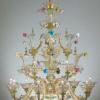
History of Murano Glass - The beginning
The history of Murano Glass is and fascinating as it is interesting. Since the 9th century, the mastery of Glass blowing turning coloured sand and molten glass into beautiful forms of art renowned the world over is simply unsurpassed. It is without doubt the longest and most prolific glass producing area in the world with trade secrets, styles and methods long protected by a fiercely proud community. The islands that make up Murano in Venice cover but a small area of a few square miles and it lies North West of Venice Italy.
The origins of Murano glass blowing it is believed, dates to the 9th century in Rome where the upheaval of various ethnic influences such as Asian and Muslim shaped it's people and eventually, the various products that Muranese glass blowing furnaces produced. In early times, it's main source of trade were multicoloured beads between it African, Muslim and Asian neighbours.
The first recorded production of Murano Glass was describe in an hist historical document which notes Domenico as a Master Glass Blower or MAESTRO who practiced the art of creating bottles. Other rare documents have described noted indivdiuals such as Pietro Fiolario who began working with Glass in 1803 and Giovani Fiolario who made bottles in and aroudn the mid 12th Century (1158)
The 13th Century brought an abundance of historical records on the growing trade of glassblowing in Venice. The craft grew so rapidly, that in the 1260’s a trade association, the Arte, was formed. In an attempt to create and formalize a body of broad rules on how glass shops were to be operated and the duties and responsibilities of both maestri and discipuli (disciples), the Capitolare was created. The earliest known version of the Capitolare dates to 1271, and was updated regularly for over 500 years until 1776. Over time, the Capitolare addressed quality control, raw material agreements and trade protection from foreign competitors. Although few glass pieces survive from the 13th century, documents from that period describe a range of utilitarian products from glasses and vases to beads and other less widely recognized objects including enameled glass, imitation jewels and richly colored window panes
Visit our website at http://www.italiandecor-glasslights.com for more information
